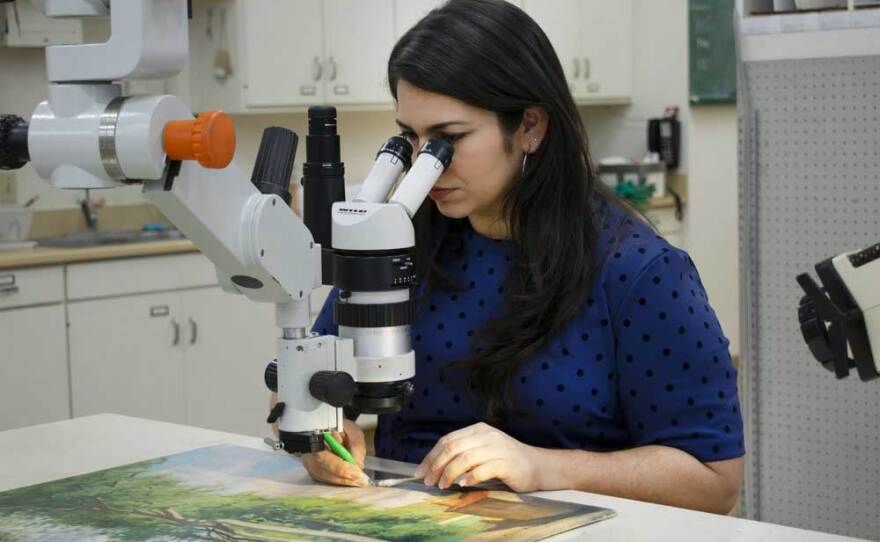Founded in 1975, the Balboa Art Conservation Center (BACC) began as a service for specific needs of the San Diego Museum of Art and the Timken Museum, housed in the SDMA building. Within a decade, they'd moved to the Casa de Balboa building across the park, and became a formal nonprofit, independent art conservation center.
Leticia Gomez Franco, BACC's executive director, said that other museums and institutions in San Diego — and across the country — soon began to see a need for conservation.
Gomez Franco said that BACC is part of a small group of nonprofit conservation organizations in the United States. "I think at this point there is maybe about nine of them throughout the country," Gomez Franco said. "And we're the only ones that exist in the entire western region."
Whose art is worthy of preservation?
Issues of public accessibility and who has access to conservation have been a heightened focus for BACC as they've reconsidered their relevance over the last few years.
The institution is taking a proactive approach to diversifying the field and the specific works they preserve, rather than waiting for institutions to diversify their collections that then come through their lab.
"There has to be a huge shift, not just in the end service of conservation," Gomez Franco said. "That end service has to be coupled with a team here that is responsive to the needs of non-Eurocentric communities."

Conversations on conservation
Each Thursday in April, BACC is hosting a series of free, public panels and informal discussions about representation, access, culturally responsive methods and approaches to conservation as well as community-led standards specific to Chicana/o/x art and cultural collections.
Each session will include a variety of voices, ranging from artists and curators to conservators, academics, community organizers and administrators.
"I think the audience is broader than the conservation field," said Bianca Garcia, art conservator at BACC. "It's definitely very appealing to the conservation field, and I wouldn't be surprised if a lot of conservators tune in. But it's also for the Chicano/Chicana/Chicanx community to also start thinking about these things."
'Con safos' and rasquachismo
"Con safos" translates to "with safety." Gomez Franco said it's effectively a tag, and an example of a consideration for conservators when it comes to Chicana/o/x art.
"Back in the '60s and '70s, when artists would make a mural or if a poet would write a poem, they would sign it with 'C' and 'S,' which is short for 'con safos,'" Gomez Franco said. "And it's basically kind of like a shield of protection, so that nobody can mess with it. So nobody could tag over it or diss it or disrespect it."
The topic recently came up at BACC when a work by Mario Terero marked with "C/S" came through the lab.

"If the 'con safos' is protecting the piece from intervention and our job as conservators is to intervene for the protection of the piece, where do we lie in all of this?" Gomez Franco said.
The theory and practice of rasquachismo is also important to discussions of preservation in Chicana/o/x art. The term generally applies to the use of the materials and objects at the artist's fingertips.
"The term is from the Chicano community, but really the practice of it exists beyond the Chicano community," Gomez Franco said. "It basically means to make do with what you have, and it really is described as an aesthetic. To me it transcends the visual aesthetic and definitely goes into process and intent, when it is a very intentional gathering of materials that have existed to meet a different kind of purpose, and they are kind of reappropriated to produce other things — and not always art."
She described examples of cans of spicy tomato paste transformed into tiny planters, or reusing margarine tubs for other household purposes. Art works can sometimes include rusty nails or cans, or scraps of cloth from the desert. If materials are supposed to age and deteriorate, a conservator has to consider intent as well as the piece.
For conservators, documentation of the artist's intentions for the materials is important with any work, as is documentation in the form of taking pictures or videos of the work if it will eventually breakdown or disappear.
"Sometimes all we can do is document," Garcia said.

Topics are "Con Safos as self-preservation" which is completed and viewable here. Zoom registration links are available here.
- "Rasquachismo Beyond Aesthetics: The Sensibilities of Documentation in Chicana/o/x Art" on April 14 at 4 p.m.
- "Inside/Outside: Preservation of Chicana/o/x Culture within/out Institutions" on April 21 at 4 p.m.
- "¿A Donde Vamos Chicana/o/x? Setting Intentions for Cultural Preservation" on April 28 at 9:30 a.m.






